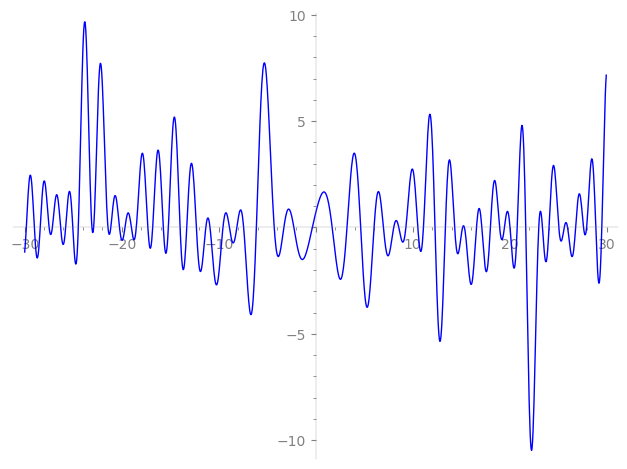| L(s) = 1 | + (−1.61 − 1.17i)2-s + 2.33·3-s + (1.22 + 3.80i)4-s − 3.10·5-s + (−3.77 − 2.75i)6-s + (2.50 − 7.59i)8-s − 3.54·9-s + (5.01 + 3.65i)10-s − 4.69i·11-s + (2.85 + 8.89i)12-s + 6.88·13-s − 7.24·15-s + (−13.0 + 9.32i)16-s − 16.9i·17-s + (5.72 + 4.17i)18-s − 26.2·19-s + ⋯ |
| L(s) = 1 | + (−0.808 − 0.589i)2-s + 0.778·3-s + (0.306 + 0.952i)4-s − 0.620·5-s + (−0.629 − 0.458i)6-s + (0.313 − 0.949i)8-s − 0.393·9-s + (0.501 + 0.365i)10-s − 0.426i·11-s + (0.238 + 0.741i)12-s + 0.529·13-s − 0.482·15-s + (−0.812 + 0.582i)16-s − 0.999i·17-s + (0.318 + 0.232i)18-s − 1.37·19-s + ⋯ |
\[\begin{aligned}\Lambda(s)=\mathstrut & 392 ^{s/2} \, \Gamma_{\C}(s) \, L(s)\cr =\mathstrut & (-0.858 + 0.512i)\, \overline{\Lambda}(3-s) \end{aligned}\]
\[\begin{aligned}\Lambda(s)=\mathstrut & 392 ^{s/2} \, \Gamma_{\C}(s+1) \, L(s)\cr =\mathstrut & (-0.858 + 0.512i)\, \overline{\Lambda}(1-s) \end{aligned}\]
Particular Values
| \(L(\frac{3}{2})\) |
\(\approx\) |
\(0.184255 - 0.668119i\) |
| \(L(\frac12)\) |
\(\approx\) |
\(0.184255 - 0.668119i\) |
| \(L(2)\) |
|
not available |
| \(L(1)\) |
|
not available |
\(L(s) = \displaystyle \prod_{p} F_p(p^{-s})^{-1} \)
| $p$ | $F_p(T)$ |
|---|
| bad | 2 | \( 1 + (1.61 + 1.17i)T \) |
| 7 | \( 1 \) |
| good | 3 | \( 1 - 2.33T + 9T^{2} \) |
| 5 | \( 1 + 3.10T + 25T^{2} \) |
| 11 | \( 1 + 4.69iT - 121T^{2} \) |
| 13 | \( 1 - 6.88T + 169T^{2} \) |
| 17 | \( 1 + 16.9iT - 289T^{2} \) |
| 19 | \( 1 + 26.2T + 361T^{2} \) |
| 23 | \( 1 - 25.8T + 529T^{2} \) |
| 29 | \( 1 + 42.2iT - 841T^{2} \) |
| 31 | \( 1 + 18.3iT - 961T^{2} \) |
| 37 | \( 1 + 49.8iT - 1.36e3T^{2} \) |
| 41 | \( 1 - 10.7iT - 1.68e3T^{2} \) |
| 43 | \( 1 + 24.1iT - 1.84e3T^{2} \) |
| 47 | \( 1 - 13.6iT - 2.20e3T^{2} \) |
| 53 | \( 1 - 6.97iT - 2.80e3T^{2} \) |
| 59 | \( 1 + 106.T + 3.48e3T^{2} \) |
| 61 | \( 1 + 93.4T + 3.72e3T^{2} \) |
| 67 | \( 1 + 89.2iT - 4.48e3T^{2} \) |
| 71 | \( 1 - 81.7T + 5.04e3T^{2} \) |
| 73 | \( 1 - 137. iT - 5.32e3T^{2} \) |
| 79 | \( 1 + 13.1T + 6.24e3T^{2} \) |
| 83 | \( 1 + 2.15T + 6.88e3T^{2} \) |
| 89 | \( 1 + 101. iT - 7.92e3T^{2} \) |
| 97 | \( 1 - 88.9iT - 9.40e3T^{2} \) |
| show more | |
| show less | |
\(L(s) = \displaystyle\prod_p \ \prod_{j=1}^{2} (1 - \alpha_{j,p}\, p^{-s})^{-1}\)
Imaginary part of the first few zeros on the critical line
−10.89653539536394943756469282492, −9.562941482200165018487847537659, −8.896331494266338325681686378084, −8.130078517493555098899142140557, −7.42994400963595553205091814062, −6.11869295532593321095656571650, −4.27721628978142795815287865265, −3.28446825547743717229708337967, −2.25133297038250612415527414781, −0.34832873143582466226277800559,
1.69688606896534723964554792978, 3.22241892223217780416052456691, 4.63332853563036902161528310186, 6.01405035281314936081814917511, 6.97879284724903165038986003722, 8.039827136116889669962392878273, 8.564212256316226207928506763082, 9.292865202082212657288111843658, 10.52656185920188534942068767304, 11.10378420170589303567734272298

